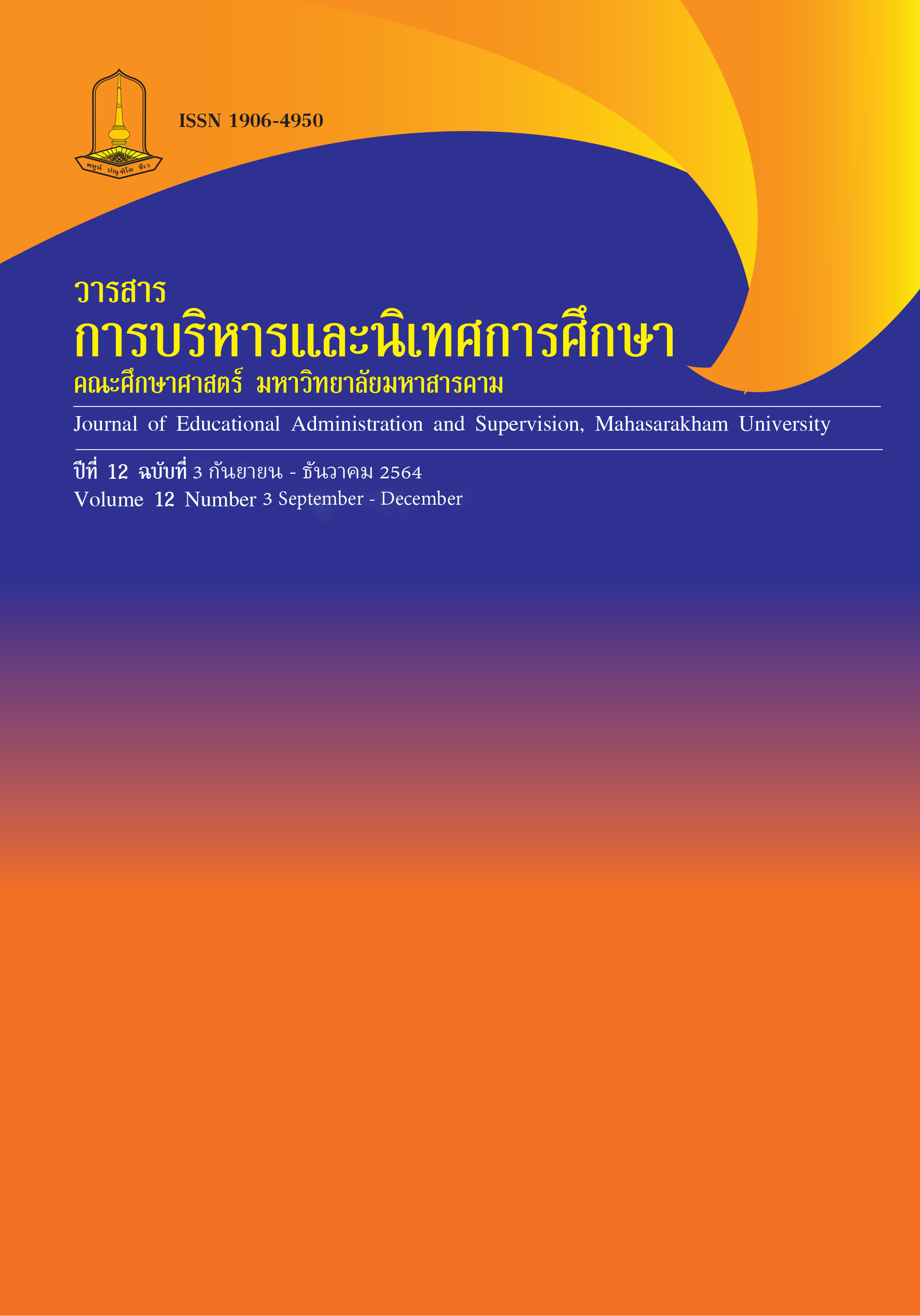The Priority Needs of Academic Administration of the Medium Tachin-Gaona Group Primary Schools Based on The Concept of Creative Problem Solvers Characteristics
Main Article Content
Abstract
This study was conducted with a descriptive style with the purposes to 1) study the present state and the desirable state of the medium Tachin-Gaona group primary schools based on the concept of creative problem solvers characteristics. 2) study the priority needs of academic administration of the medium Tachin-Gaona group primary schools based on the concept of creative problem solvers characteristics. The population was the members of the medium Tachin-Gaona group primary schools of Nakhon Pathom Primary Education Service Area Office 2. The informants consisted of 7 directors of school and 74 teachers.
The total of this research were 81 informants. The research instruments were rating scale questionnairs about present state and desirable state. The data were analyzed by frequency distribution, percentage, mean, standard deviation and Modified Priority Need Index (PNImodified The results were as follows: 1) The present states in academic administration of the medium Tachin-Gaona group primary schools based on the concept of creative problem solvers characteristics were at the high level (X=3.928). The desirable states in academic administration of the medium Tachin-Gaona group primary schools based on the concept of creative problem solvers characteristics were at the highest level (X=4.562, S.D. =0.505).
2) The highest priority needs index of the medium Tachin-Gaona group primary schools based on the concept of creative problem solvers characteristics was the curriculum development
(PNImodied 0. 176); the second priority needs index was the development approaches for using media and educational technology (P modified 0. 162); the third priority needs index was the measurement and evaluation approaches (PNI=0.156) and the last prioritymodifiedneeds index was the teaching (PN modified 0. 152).
Downloads
Article Details
References
กฎกระทรวง. (2550). หลักเกณฑ์และวิธีการกระจายอำนาจการบริหารและการจัดการศึกษา. สืบค้นเมื่อ3 สิงหาคม 2563, จาก http://www.ratchakitcha.soc.go.th/DATA/PDF/2550/A/024/
PDF.
เกรียงศักดิ์ เจริญวงศ์ศักดิ์ (2553). การคิดเชิงสร้างสรรค์. พิมพ์ครั้งที่ 8. กรุงเทพฯ: ซัคเซส มีเดียจามจุรี จำเมือง. (2552). คู่มือเตรียมสอบผู้บริหารสถานศึกษาและผู้บริหารการศึกษา. กรุงเทพฯ:เจริญดีมั่นคง.
ทิศนา แขมมณี. (2556). ศาสตร์การสอน พิมพ์ครั้งที่ 17. กรุงเทพฯ: สำนักพิมพ์แห่งจุฬาลงกรณ์มหาวิทยาลัย.
นิพาดา เทวกุล. (2558) ความคิดสร้างสรรค์ สืบค้นเมื่อ 16 สิงหาคม 2563, จาก http://pirun.kuac.th/agrpct/envelop/creative%20think.pdf.
ภาวิดา ธาราศรีสุทธิ. (2550). การจัดและการบริหารงานวิชาการ. กรุงเทพฯ: มหาวิทยาลัยรามคำแหง.
รุ่งชัชดาพร เวหะชาติ. (2550). การบริหารงานวิชาการ สถานศึกษาขั้นพื้นฐาน. สงขลา: มหาวิทยาลัยทักษิณ.
สำนักวิชาการและมาตรฐานการศึกษา. (2557). แนวปฏิบัติการวัดและประเมินผลการเรียนรู้ ตามหลักสูตรแกนกลางการศึกษาขั้นพื้นฐาน พุทธศักราช 2551. สืบค้นเมื่อ 3 สิงหาคม 2563, สืบค้น
on http://www.satit.mua.go.th/dataS/OHEC_document/201807121546.pdf.
สำนักบริหารงานการมัธยมศึกษา. (2555). มาตรฐานการปฏิบัติงานโรงเรียนมัธยมศึกษา พ.ศ.2555.สืบค้นเมื่อ 3 สิงหาคม 2563, จาก http://www.thaischool1.in.th/site/documentschoo-
download.php?doc_id=932.
สำนักเลขาธิการสภาการศึกษา. (2562). สภาวะการศึกษาไทย 2561/2562 การปฏิรูปการศึกษาในยุคดิจิทัล. กรุงเทพฯ. ภาพพิมพ์,
สำนักงานสถิติแห่งชาติ. (2562). รายงานสำรวจสถานการณ์เด็กและสตรีในประเทศไทย, สืบค้นเมื่อ 13
กรกฎาคม 2563, จาก http://www.nso.go.th/sites/2014/Pages/สำรวจ/ด้านสังคม/แรงงาน/สถานการณ์เด็กและสตรีในประเทศไทย.aspx.
สิทธิชัย ชมพูพาทย์. (2554). การพัฒนาพฤติกรรมการเรียนการสอนเพื่อการแก้ปัญหาอย่างสร้างสรรค์ของครูและนักเรียนโรงเรียนส่งเสริมนักเรียนที่มีความสามารถพิเศษทางวิทยาศาสตร์โดยใช้วิจัยเชิงปฏิบัติการเชิงวิพากษ์. วิทยานิพนธ์ปริญญาดุษฎีบัณฑิต, มหาวิทยาลัยศรีนครินทรวิโรฒ,กรุงเทพฯ.
สุวิมล ว่องวาณิช. (2558). การวิจัยประเมินความต้องการจำเป็น พิมพ์ครั้งที่ 3. กรุงเทพฯ: สำนักพิมพ์จุฬาลงกรณ์มหาวิทยาลัย.
Chinkee Tan. (20 19). 5 Characteristics of A Good Problem Solver. Retrieved January 2, 202 1.
from https://www.goodnewspilipinas.com/5-characteristics-of-a-good-problem-solver./Dewett, T. (2007). Linking intrinsic motivation, risk taking, and employee creativity in an R&D
environment. R&D Management, 37 (3), 197-208.
Isaksen, S.G., Treffinger, D.J. & Selby, E.C. (2007). Understanding individual problem-solving
style: A key to learning and applying creative problem solving. Learning and Individual Difference, 18(1), 390-40 1.
Isaksen, S.G. et al. (20 11). Linking Problem-Solving Style and Creative Organizational Climate:An Exploratory Interactionist Study. The International Journal of Creativity & Problem Solving, 21(2), 7-38.
Seaward, B.L. (20 12). Managing Stress: Principles and Strategies for Health and Well-Being.Sudbery: Jones & Bartlett Learning.
Tesluk et al. (1997). Influences of Organizational Culture and Climate on Individual Creativity.
Journal of Creative Behavior, 31 (1), 27-41.
better_b_8253728.
Ulli Appelbaum. (2017). 7 'Tips' to Become a Better Creative Problem-Solver. Retrieved
January 2, 2021. from https://www.huffpost.com/entry/7-tips-to-become-a-
Véronique Sylvain. (2003). Creative Problem-Solving Test. Retrieved December 25, 2020,
from https://testyourself.psychtests.com.
Wheeler, D.K. (1978). Curriculum process. London: Hodder & Stoughton.


